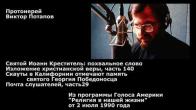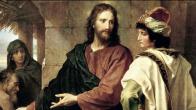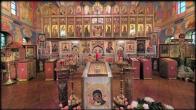You are here
Holy Water
Traditionally, on July 28, after the Liturgy for the Feast day of Great Prince St. Vladimir, we serve the rite of the Lesser Blessing of the Waters, in commemoration of the Baptism of Rus’. We believe that in this regard it would be appropriate to remember what Holy Water means for the life of Orthodox Christians, and to respond to questions such as, “What kinds of Holy Water exist in Orthodox Christian tradition, and why are they necessary?”
Water in the Bible
Water is one of the most ancient of religious symbols, and has a key role in Sacred Scripture. At the very beginning of the Creation of the world, inchoate, formless matter is referred to as water. “In the beginning,” after God created Heaven and the earth, “The Spirit of God moved upon the face of the waters.” According to the Biblical account of the creation of the world, it was out of the waters that the first living creatures came – “the moving creature that hath life,” fish, “every living creature that moveth, which the waters brought forth abundantly.” Water also plays a very important role in the life of man, created “from the dust of the earth.”
Man is part of the world. Spiritually belonging to the world of the heavenly, the spiritual, man belongs in body entirely to the material world, in which water is so important, existing wherever any form of life exists. Thus, the first aspect of water’s religious symbolism is as a primal force that brings life.
Yet, water can also become an awesome, terrible element, a symbol of death and destruction. Water’s mysterious black depths can kill and destroy, can wipe entire civilizations from the face of the earth, can become the image of irrational, uncontrollable, chaos. As we read in the first Book of the Holy Bible, the first human world perished in the waters of the Great Flood. That was the means God chose to destroy the world in which evil had absolutely prevailed over the good. Is this not a sign of the fact that when man lives in evil, the world itself, created by God to be in harmony with man, rebels against its Sovereign? Christians believe that the first people’s fall into sin not only harmed man himself, but also introduced an imbalance into the entire structure of the world: People’s relationships with one another and with the world became something other than what God intended for them, and water, at one time the source of life, became a natural disaster, bringing death.
However, having become a destructive force, water as a symbol acquired yet another dimension: as a force of cleansing. At God’s direction, the waters of the Flood cleansed the earth of its complete domination by sin. Purity, rebirth, and renewal constitute the third aspect of water’s symbolism in Biblical culture. Water washes away dirt, cleanses our bodies, clothing and homes. This symbol, based on water’s natural attributes, is found throughout the Bible.
The Greater Blessing of the Waters
Water as the well-spring of life, as a symbol of judgment and death, as a means of purification – three basic dimensions of water as a religious symbol – is tied to three fundamental emphases of the Christian faith: Creation, the fall into sin, and redemption. The whole world, with water as a component part and man as its “crown,” were created by God as good, as essentially “blessed.” Yet that same fundamentally “good” matter was the instrument of man’s fall, causing his enslavement to sin and death. However, in Christ, God Incarnate, and his power, matter can once again become the symbol of God’s presence and His glory, can become the fabric of a mystery that unites man with God.
Every time there is a Holy Baptism, a rite known as the Great Blessing of the Water, is performed. It is also performed on the eve of the Feast of the Baptism of the Lord. The prayers read during this rite are a celebration of praise and thanksgiving, addressed to God on behalf of the whole world. To consider the Blessing of the Waters as a “sanctification” of a certain amount of material is too narrow an understanding. One can see in the prayers, composed many centuries ago, that their authors’ idea was that water should be made once again capable of becoming the manifestation and presence of God’s power and love in this fallen, yet redeemed, world.
The words of thanksgiving in the Greater Blessing of the Waters make us eyewitnesses to the Creation, returning us to the very well-springs of life. And with the capacity to give thanks, man becomes free, in relationship both to God and to the world.
The priest prays, “Show this water to be the water of regeneration, the water of sanctification, the purification of flesh and spirit, the loosing of bonds, the remission of sins, the illumination of the soul, the laver of regeneration, the renewal of the spirit, the gift of adoption to sonship, the garment of incorruption, the fountain of life...” No blessing performed by the Church is ever a visible, “physical” miracle, some kind of transformation that is “palpable” and subject to being proven. Believers should not be troubled by the question of whether some kind of laboratory analysis or test might “prove” whether there has been some change in matter or not. One could even say that the Church often saw expectation of, or search for, such “transformations” as blasphemous and sinful. After all, Christ did not come to replace “natural matter” with something “supernatural” or “sanctified.” The Son of God was Incarnate that He might open for us the path to unification with God. He returns to matter its original attribute: to serve as the means for such unification. Thus, the Baptismal water, the water at the Greater Blessing of the Waters, is holy, i.e. it becomes a place where Christ and the Holy Spirit are present.
The Lesser Blessing of the Waters
In addition to the Greater Blessing of the Waters, which is performed rather infrequently (the water remaining at the conclusion of the Mystery of Holy Baptism is not further used), Church Tradition developed a rite of the “Lesser Blessing of the Waters.” That rite is based on a different concept of blessing. While the Greater Blessing of the Waters, of which we spoke above, is effected first and foremost through the prayer itself, in the Lesser Blessing of the Waters, a key role is played by an object that is immersed in the water: the Holy Cross, as an image of the Cross of Christ. By the way, there is no significance in what material is used to fashion the Cross. What is important is that the Cross is a holy thing, as a symbol of Christ’s victory over death.
Thus, Church Tradition recognizes two methods of blessing: through direct prayer and through contact with something that is already blessed. (...)
Why is this necessary?
Blessing of the Waters, like any liturgical action, is not something in isolation. Thus, during the Liturgy, bread and wine are blessed to become the means of true unification with God. Water is blessed not be kept for years in a closet, but to be used, so that it might manifest remission of sins, deliverance, salvation, sanctification of soul and body, so that, as the remarkable 20th Century theologian Alexander Schmemann wrote, “it might be what all matter was intended to be: the way to the ultimate goal, man’s theosis, coming to know God, and uniting with Him.”
Priest Andrei Dudchenko
abridged; reprinted from www.pravmir.ru
PARISH LIFE
RECENT VIDEOS
Address of our Cathedral
Subscribe to our mailing list
While all the materials on this site are copyrighted, you may use them freely as long as you treat them
with respect and provide attribution on the Russian Orthodox Cathedral of St.John the Baptist of Washington DC.









